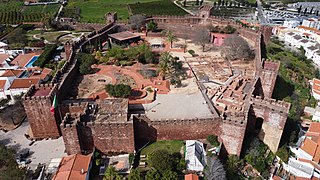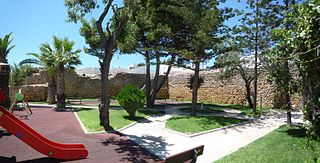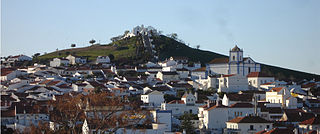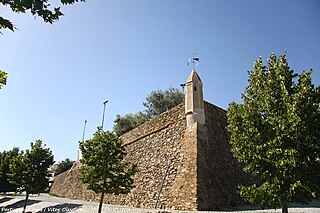
Alcantarilha is a former civil parish in the municipality of Silves, Portugal. In 2013, the parish merged into the new parish Alcantarilha e Pêra. With an area of 19.54 square kilometres (7.54 sq mi) the population of 2347 inhabitants is dispersed throughout the territory.

The Castle of Paderne is an ancient fortification located in the civil parish of Paderne, municipality of Albufeira, in the Portuguese Algarve. It was constructed in the later 12th century by Berbers, in an area around 7.5 kilometres (4.7 mi) inland.

The Castle of Silves is a castle in the civil parish of Silves in the municipality of Silves in the Portuguese Algarve. It's believed that the first fortifications were built upon a possible Lusitanian castro, by the Romans or Visigoths. Between the 8th and 13th centuries, the castle was occupied by the moors who expanded it, making it one of the best preserved Moorish fortifications in Portugal, resulting in its classification as a National Monument in 1910.

The Fort of São João do Arade, sometimes referred to as the Castle of Arade, is a medieval fortification situated in the civil parish of Ferragudo in the Portuguese Algarve municipality of Lagoa.

The Castle of Carrazeda de Ansiães, normally shortened to Castle of Ansiães, is a medieval castle in the civil parish of Lavandeira, municipality of Carrazeda de Ansiães of Portugal.

The Castle of Alcoutim is a medieval castle in the civil parish of Alcoutim, in the municipality of the same name, in the southeastern Algarve of Portugal. Built in the 13th century, the castle stands in a dominant position on a hill south of the parish seat of Alcoutim on the right bank of the San Marcos River, opposite the territory of Sanlúcar de Guadiana.

The Castle of Aljezur is a medieval castle founded in the parish of Aljezur, in the municipality of the same name overlooking the Aljezur River. Excavations in the castle have discovered that the location was occupied during the Bronze and Iron Ages, while the parade grounds, habitational structures, and two silos date to the 12th and 13th centuries.

The Castle of Alvor is a medieval castle in the civil parish of Alvor, in the Portuguese district of Faro: considered to be a significant military monument associated with the nearby Castle of Silves.

The Castle of Castro Marim is a medieval castle on a hilltop overlooking the civil parish of Castro Marim, in the municipality of the same name, in the Portuguese Algarve. The castle was part of the defensive line controlled by the Knights Templar, a stronghold used during the Portuguese Reconquista, and adapted during the Restoration War to defend the frontier.

The Roman Ruins of Cerro da Vila are the remnants of a historical villa in the Algarve region of southern Portugal. Its vestiges lie in the vicinity of the resort and marina of Vilamoura, in the civil parish of Quarteira, municipality of Loulé Municipality.

The Castle of Alandroal is a medieval castle in the civil parish of Alandroal, São Brás dos Matos e Juromenha, municipality of Alandroal, Portuguese district of Évora, classified as a National Monument.

The Castle of Alcanede, is a Portuguese medieval castle in civil parish of Alcanede, in the municipality of Santarém, in the Ribatejo district of Santarém.

The Castle of Alenquer, is a Portuguese medieval castle in civil parish of Alenquer, in the municipality of Alenquer, in the district of Lisbon.

The Castle of Aljustrel, is a Portuguese medieval castle in civil parish of Aljustrel e Rio de Moinhos, in the municipality of Aljustrel, in the district of Beja.

The Castle of Arronches, is a Portuguese medieval castle in civil parish of Assunção, in the municipality of Arronches, in the district of Portalegre.
The Castle of Barbacena is a former-medieval castle/fort in the civil parish of Barbacena e Vila Fernando, municipality of Elvas in the Portuguese Alentejo, classified as a Property of Public Interest.

The Castle of Folgosinho, is a medieval castle in the civil parish of Folgosinho, municipality of the Gouveia in the district of Guarda in the Centre region of Portugal.
The Castle of Seda is a medieval castle located in the civil parish of Seda, in the municipality of Alter do Chão, in the Portuguese district of Portalegre.

The Castle of Pena de Aguiar is a medieval castle, alternately the Castle of Aguiar da Pena, situated in the civil parish of Telões, in the municipality of Vila Pouca de Aguiar, in the Portuguese district of Vila Real.

The Castle of Castelo Bom, is a medieval castle in the civil parish of Castelo Bom, municipality of the Almeida in the district of Guarda in the Centre region of Portugal.





















